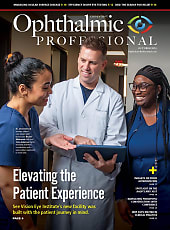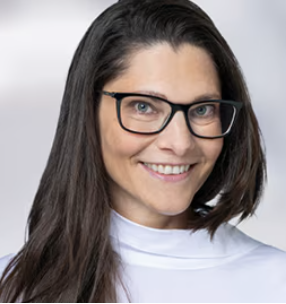For this month's Retina Minute, I have the pleasure of interviewing my dear friend Marion Munk, who is currently a medical retina and uveitis specialist at the Gutblick Clinical Practice Group in Switzerland, professor at University Bern, Switzerland and CMO at Isarna Therapeutics.
Recently, Prof. Munk, you presented some interesting data at ARVO about the latest research at Isarna Therapeutics. Can you explain it for our readers?
First, Dr. Singer, thank you very much for the kind invitation. It is a great opportunity to be here. We are currently assessing our lead compound ISTH0036—a locked nucleic acid-modified antisense oligonucleotide selectively targeting the messenger RNA (mRNA) of TGF-β2, a key driver of retinal fibrosis. At Isarna, we just finished a multicenter phase 2 trial that assessed the safety and efficacy of this compound. We included treatment-naïve patients as well as stable, inactive, pretreated patients with neovascular age-related macular degeneration (nAMD) and diabetic macular edema (DME) who also had severe nonproliferative and mild proliferative diabetic retinopathy. The patients received ISTH0036 every other month. Between treatments, they were eligible to receive aflibercept (Eylea; Regeneron) if they met rescue criteria.
The primary endpoint was assessed after 7 months, followed by a safety period of 2 months during which no injections were given so we could further investigate the drug’s durability. Most patients did not need any additional aflibercept injections to remain dry or get dry, so blocking the production of TGF-β2 was able to control the pathology of nAMD and DME as monotherapy. We saw a robust decrease in central retina thickness (CRT) in the treatment-naïve patients and stable CRT in pretreated patients. In the DME pretreated cohort, we saw an additional CRT decrease.
We also assessed the antifibrotic property of this agent, specifically the hyperreflective material in nAMD patients on optical coherence tomography, which was consistent with the presence of fibrosis on color fundus. We saw a 70% decrease of this hyperreflective material during the trial—a key differentiator compared with the current standard-of-care, anti-VEGF drugs. We also saw favorable safety profiles: Most adverse events were mild, 11 were moderate, and none were severe.
Was there any intraocular inflammation (IOI)?
We had one patient with IOI who also had uncontrolled diabetes, but this patient had experienced IOI already before the trial, so the investigator did not consider it to be related to the study drug.
What were the total number of patients and the breakdowns for AMD, DME, treatment-naïve, and previously treated patients?
The goal was to have 12 patients per group, and we included 43 patients in total. We were not able to recruit the full number of patients in the pretreated DME group because they needed to have severe nonproliferative or mild proliferative diabetic retinopathy in addition to being pretreated, which can be difficult to find. We only had five patients in that group. The pretreated nAMD group was also not fully recruited.
What was the criteria for DME in the pretreated group?
CRT did not exceed 320 micrometers.
Previously both nAMD and DME patients had rescue treatment. How about in the treatment of naïve nAMD patients?
Most (74%) of the DME patients did not need any additional aflibercept injections during the course of the study. Only 36% of treatment-naïve and pretreated nAMD patients required an additional aflibercept injection.
What was the criteria for a supplemental aflibercept injection?
It was either a five-letter loss, or a CRT increase of 10%, compared to the best previous value. In patients with treatment-naïve nAMD, the criteria for rescue was also no change in intra- or subretinal fluid.
Did patients experience an effect immediately, or was it a prolonged effect that built up over time?
This is an excellent question. The mode of action of an antisense molecule is to block the production of new proteins inside the cells. Once injected, ISTH0036 suppresses the de-novo synthesis of TGF-β2. This means that the TGF-β2 proteins that are already in the eye are still active. We saw in the study that ISTH0036 needs about 1 month until its effects kick in, but then it has a long-lasting effect—in animal models we have seen a stable TGF-β2 suppression for at least 4 months after a single injection.
This is why I think the most successful group was our fifth group, our so-called treatment-naïve, primed patients. These patients were treatment-naïve nAMD patients who received one injection of anti-VEGF and were then followed up with ISTH0036 a month after the anti-VEGF. Here, we saw the most robust CRT decrease and the most robust improvement in vision function.
What was the effect on vision in different treatment populations, and what was the mean improvement in vision?
At the end of the study, we saw a mean improvement of 11 letters in the nAMD treatment-naïve, anti-VEGF primed group. Improvement was lower in the other groups. Interestingly, we have seen continuous improvement in some patients who were on anti-VEGF before, but what is important is that there was an effect of the lens status: Pseudophakic patients presented with much better gain in vision after ISTH0036.
What was the difference in pseudophakic patients’ vision scores vs the overall patient population?
The groups were small, so we had to combine DME and nAMD patients, but we saw a significant gain in pseudophakic patients.
What percent of patients were rescued, and when were they rescued?
The need for an additional aflibercept injection depended on the patient population and ranged from 0% of pretreated DME patients to 40% of treatment-naïve nAMD patients. Thus, most patients did not need any additional rescue to control the disease activity.
A minority of nAMD patients were active and needed an additional aflibercept injection every other month. We are aware of these patients with all the current anti-VEGF drugs as well: These are patients who lead to this sawtooth sign in fixed 8 weekly treatment intervals because they have a high treatment need. But these were only a few nAMD patients. The other patients received rescue treatment at the end of the study at the primary endpoint after 7 months. None of the pretreated DME patients needed any additional aflibercept injections and still showed additional CRT decrease.
Did patients need more than one rescue?
Most patients who needed rescue needed it at the end of the study, but some active treatment-naïve nAMD patients received aflibercept at every safety visit, so they had bimonthly aflibercept injections on top of the bimonthly ISTH0036 injections.
What was the percent of patients who had cataract progression of that group?
We had four adverse events related to cataract progression. Two were considered by the investigator to be related to the study drug. Overall, we saw a mean increase of the mean LOCS III score over the course of the study from 4.5 to 5.8 at the primary endpoint. We discussed this with our steering committee, which was composed of leading global retina specialists, and they did not see this as an issue or a showstopper because most patients—around 90% at baseline—had some signs of cataract and would need a cataract surgery anyway. Nonetheless, this fact needs to be considered in the next trial design.
As you design your phase 2B trial, will you keep phakic patients or will you try to screen for pseudophakic patients only to get the maximum effect?
To give the drug the best chance, it would be wise to only include pseudophakic patients. However, we must see how much this may affect the recruitment, and we may stratify based on the lens status.
What is the next step for this medicine?
We really believe in the drug. We are actively looking for development partners and we are raising money to continue the development of this exciting drug, which directly addresses a high unmet medical need in retina therapy. We are also working with regulatory agencies and key opinion leaders like you to define the best design for the pivotal studies.
Fibrosis is currently a hot topic in the community: 50% of patients show subretinal fibrosis after 2 years of adequate and intensive anti-VEGF treatment, which leads to significant vision loss. Of course, our drug does not have the same antiedematous property as anti-VEGFs do, but we address the unmet need for a drug that helps to optimize visual function benefits and keep them long-term.
This is fascinating work. We are doing well in terms of anti-VEGF, but obviously we have not been able to deal with the problem of fibrosis or the multifactorial nature of diabetes. Having a new mechanism of action may allow us to treat our diabetic patients more effectively as well as increase the interval and prognosis for our wet AMD patients. We are excited to keep abreast of what the next stage brings. Thank you so much for talking to us.
Thank you for your interest.
This editorial content was supported via unrestricted sponsorship.










